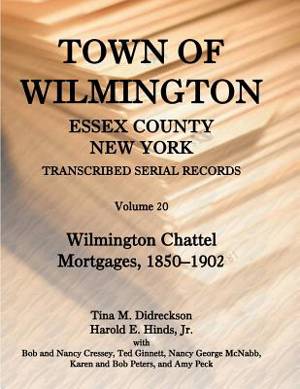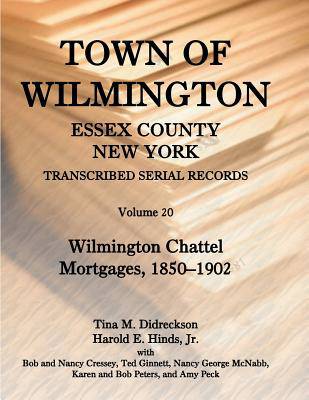
- Afhalen na 1 uur in een winkel met voorraad
- Gratis thuislevering in België vanaf € 30
- Ruim aanbod met 7 miljoen producten
- Afhalen na 1 uur in een winkel met voorraad
- Gratis thuislevering in België vanaf € 30
- Ruim aanbod met 7 miljoen producten
Zoeken
Town of Wilmington, Essex County, New York Transcribed Serial Records, Volume 20
Wilmington Chattel Mortgages, 1850-1902
Harold E Hinds, Tina M Didreckson
Paperback | Engels
€ 23,95
+ 47 punten
Omschrijving
This volume is the twentieth in a series devoted to presenting a transcription of the surviving serial manuscript records for the town of Wilmington, Essex County, New York, in the High Peaks region of the Adirondack Mountains. Surviving records include chattel mortgages, which are a frequently overlooked resource. Chattel mortgages are especially valuable because there were no banks in Essex County during much of the nineteenth century. Money was borrowed from private individuals and businesses, such as the general store or blacksmith. Both the borrowers and the lenders are captured in the chattel mortgage records. Chattel mortgages contain important details, the most significant of which have been abstracted: the names of the mortgagor and the mortgagee, and their place of residence, if given; the date of the instrument; what had been put up as collateral; the loan; the terms of the loan, generally when a note came due; the witness(es) to the chattel mortgage; and the resolution of the mortgage if known. In addition, chattel mortgages describe possessions with more specificity than probate inventories or the various agricultural and industrial censuses, which is particularly important since evidence for the possessions of nineteenth century rural inhabitants is generally sparse. The entries have been transcribed as presented, with all variations for the same individual's name included in the index; the original spelling has been maintained. A full name index adds to the value of this work.
Specificaties
Betrokkenen
- Auteur(s):
- Uitgeverij:
Inhoud
- Aantal bladzijden:
- 176
- Taal:
- Engels
Eigenschappen
- Productcode (EAN):
- 9780788454011
- Verschijningsdatum:
- 1/10/2013
- Uitvoering:
- Paperback
- Formaat:
- Trade paperback (VS)
- Afmetingen:
- 216 mm x 279 mm
- Gewicht:
- 421 g

Alleen bij Standaard Boekhandel
+ 47 punten op je klantenkaart van Standaard Boekhandel
Beoordelingen
We publiceren alleen reviews die voldoen aan de voorwaarden voor reviews. Bekijk onze voorwaarden voor reviews.








